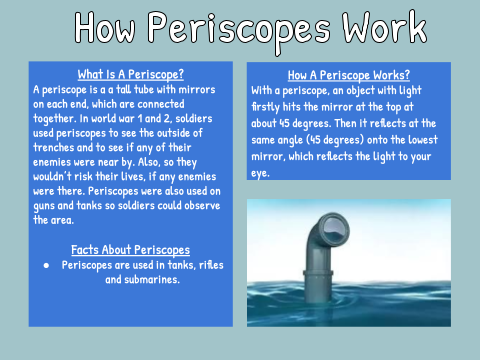This week for Inquiry, Mr Johnston came over to LS2 and taught us about periscopes and how they are used. Cassius and I worked together to create a DLO about periscopes, including what a periscope is, an interesting fact and how they work. Mr Johnston taught us that the angle of incidence equals to the angle of reflection. Something interesting I had found out was that soldiers used periscopes to observe the area to see if their enemies were near by.
I am a Year 8 student at Panmure Bridge School in Auckland, NZ. I am in Learning Space 2 and my teacher is Mrs Anderson.
Tuesday, 23 June 2020
Periscopes
LI: To explain how periscopes work.

This week for Inquiry, Mr Johnston came over to LS2 and taught us about periscopes and how they are used. Cassius and I worked together to create a DLO about periscopes, including what a periscope is, an interesting fact and how they work. Mr Johnston taught us that the angle of incidence equals to the angle of reflection. Something interesting I had found out was that soldiers used periscopes to observe the area to see if their enemies were near by.
This week for Inquiry, Mr Johnston came over to LS2 and taught us about periscopes and how they are used. Cassius and I worked together to create a DLO about periscopes, including what a periscope is, an interesting fact and how they work. Mr Johnston taught us that the angle of incidence equals to the angle of reflection. Something interesting I had found out was that soldiers used periscopes to observe the area to see if their enemies were near by.
Subscribe to:
Post Comments (Atom)
No comments:
Post a Comment
Note: only a member of this blog may post a comment.